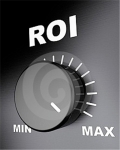2010 will be the year that social media earns its rightful place along side other traditional marketing media. Many teams have managed to grow a toe hold into a solid foot in the door and with that comes the inevitable ROI question.
If you are looking to layer social media as part of your sponsorship inventory, here are a few ideas/tips on how to get started:
1. Profile Your Base
If you have 100 or so brands that you work with, you should start by profiling your account base. By that, I mean to map out commonalities in the industries (retail, beverage, financial, etc…) and get a picture of what kinds of businesses you are working with. Finding similarities can provide the path of common strategies and approaches to speak the language of your customer. Profiling your base will give you a deeper understanding of what you have to work with.
2. Build a Social Media Matrix
Take those 100 brands and determine which ones are already active in social media. Do they have a Facebook Page or a Twitter feed? Are they active in this space? This is your “A” list.
The next group would be the “me too” brands that are emerging social media marketers. Small followers and small fans, less than consistent content and engagement. This is your “B” list.
The remaining group of brands are your “C” list – brands that are not yet active in social media or not interested.
3. Engage Your “A” List
Time to become a fan and follow your “A” list. You might consider building an alias profile to do this. The idea here is to understand how the brand operates within these platforms and get a real feeling for what the brand is about and how their social media strategy is playing out. Spend a bit of time on this as the information and insight you gain will be very valuable down the road when it is time to talk about alignment.
By alignment, I mean that you will be looking for brands that would be interested to partner with/leverage the online brand that your team represents in the same social media spaces.
4. Collaborate with Your “A” List
Request to meet with your partners to discuss their social media strategies. Find out what their goals are – what their challenges are – what their successes have been. Successful social media sponsorships are built collaboratively with the sponsor and are unique and custom in their approach. Creative teams, web teams and marketing teams need to be in communication to pull ideas together into promotions and campaigns. It’s all about working together, not about just another piece of inventory to sell.
5. Farm the “B” List
Meanwhile, your “B” list may see the opportunity to work with you as a chance to establish their social media presence. Keep going back to this group who may consider you a thought leader and look to find ways to leverage your presence and market. Your “B”s want to be here, and they see you as being in a position to help them. Stay close to them, but spend your time preaching to the converted with your “A” list.
6. Wait for the “C” List to Catch Up
Sponsorship sales can be difficult enough – you shouldn’t be spending your time and energy educating on social media benefits and strategies. These brands will catch up if they feel the need or simply continue on with current marketing efforts outside of the social media sphere. This isn’t a criticism, just the highest and best way to spend your time when social space sales are on the table.
I hope this gives you some ideas and plans on how to approach your base. Remember these are not off the shelf deals – this is not about dropping a link into your Twitter stream or posting a sponsored status update. There is a great deal more at stake in the social space for teams, brands and fans – engagement and collaboration is the key and there must be something in it for everyone.































